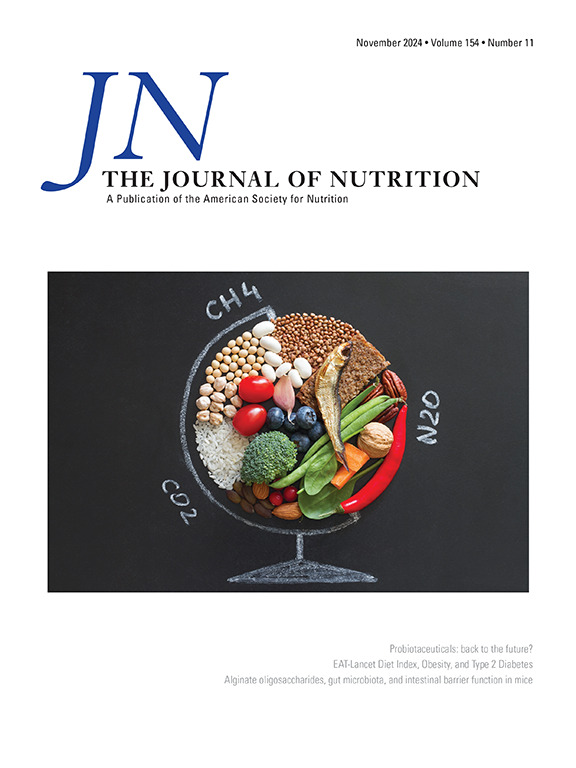Milk Protein Glycation Compromises Postprandial Lysine Bioavailability but does not Modulate Postprandial Muscle Protein Synthesis Rates In Vivo in Males: A Double-blind, Randomized Parallel Trial
IF 3.7
3区 医学
Q2 NUTRITION & DIETETICS
引用次数: 0
Abstract
Background
Industrial processing and storage of milk products can strongly increase protein glycation level. Previously, we have reported that a high protein glycation level impairs protein digestion, thereby compromising lysine bioavailability. The lower postprandial lysine availability may restrict the anabolic properties of a high glycated protein.
Objectives
The objective of this study was to assess the impact of milk protein glycation on postprandial plasma amino acid availability and subsequent postprandial muscle protein synthesis rates during recovery from a single bout of resistance-type exercise.
Methods
Forty-five recreationally active, healthy young males participated in this double-blinded, randomized parallel study. After performing a single bout of whole-body resistance-type exercise, subjects ingested 20 g milk protein with either a low (4%; LOW-GLYC) or high (47%; HIGH-GLYC) glycation level or a noncaloric placebo (PLA). Continuous intravenous infusion of L-[ring-13C6]-phenylalanine was combined with the collection of blood and muscle tissue samples during a 6-h postprandial period to assess plasma amino acid concentrations and muscle protein synthesis rates.
Results
Protein ingestion increased plasma total and essential amino acid concentrations compared with placebo (time × treatment interaction: P < 0.001), with no differences between the low and high glycated milk protein. Plasma lysine availability, assessed over the full 6 h postprandial period, was substantially lower following ingestion of the protein with the high versus low glycation level (−5 ± 7 compared with 10 ± 9 mmol · L-1 · 360 min, respectively, P < 0.001). Postprandial muscle protein synthesis rates did not differ between treatments (0.059 ± 0.016, 0.061 ± 0.012, and 0.061 ± 0.018 % · h-1, in LOW-GLYC, HIGH-GLYC and PLA, respectively, P = 0.939).
Conclusions
Ingestion of protein with a higher glycation level attenuates postprandial plasma lysine availability. Milk protein glycation does not modulate postprandial muscle protein synthesis rates during recovery from resistance exercise in healthy, young males.
This trial was registered at the Dutch Trial Register as NL8690; https://onderzoekmetmensen.nl/nl/trial/49398.
牛奶蛋白糖基化损害餐后赖氨酸的生物利用度,但不调节男性餐后肌肉蛋白质合成率:一项双盲随机平行试验。
背景:乳制品的工业加工和储存可显著提高蛋白质糖基化水平。以前,我们曾报道过高蛋白糖基化水平会损害蛋白质消化,从而影响赖氨酸的生物利用度。较低的餐后赖氨酸可利用性可能限制高糖化蛋白的合成代谢特性。目的:评估牛奶蛋白糖基化对单次阻力型运动恢复过程中餐后血浆氨基酸利用率和随后餐后肌肉蛋白质合成率的影响。方法:45名从事娱乐活动的健康年轻男性参加了这项双盲、随机平行研究。在进行一次全身抵抗型运动后,受试者摄入20克牛奶蛋白,其中低(4%;低血糖)或高(47%;高糖基化水平,或无热量安慰剂(PLA)。持续静脉输注L-[ring-13C6]-苯丙氨酸,并在餐后6小时采集血液和肌肉组织样本,评估血浆氨基酸浓度和肌肉蛋白合成率。结果:与安慰剂相比,蛋白质摄入增加了血浆总氨基酸和必需氨基酸浓度(时间*治疗相互作用:p结论:摄入糖基化水平较高的蛋白质会降低餐后血浆赖氨酸的可用性。在健康的年轻男性中,牛奶蛋白糖化不会调节从抗阻运动中恢复的餐后肌肉蛋白质合成率。该试验在荷兰试验登记册上登记为NL8690;https://onderzoekmetmensen.nl/nl/trial/49398。
本文章由计算机程序翻译,如有差异,请以英文原文为准。
求助全文
约1分钟内获得全文
求助全文
来源期刊

Journal of Nutrition
医学-营养学
CiteScore
7.60
自引率
4.80%
发文量
260
审稿时长
39 days
期刊介绍:
The Journal of Nutrition (JN/J Nutr) publishes peer-reviewed original research papers covering all aspects of experimental nutrition in humans and other animal species; special articles such as reviews and biographies of prominent nutrition scientists; and issues, opinions, and commentaries on controversial issues in nutrition. Supplements are frequently published to provide extended discussion of topics of special interest.
 求助内容:
求助内容: 应助结果提醒方式:
应助结果提醒方式:


